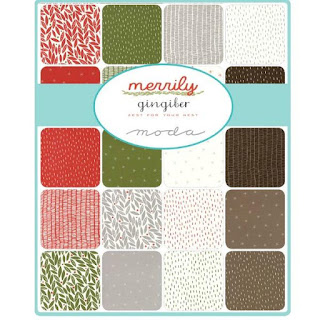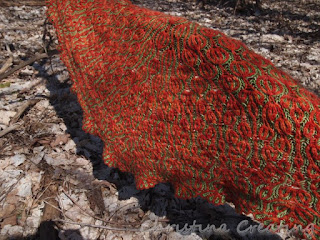I also liked the designs and soft colours of the coordinating fabric line. By the time I discovered it, the fabric was getting old so it wasn't stocked in many places. (The danger of looking through older magazines.) But I did manage to find two layer cakes (a set of 42 10" squares). The layer cakes include of all of the fabric from the line.
I figured two layer cakes would be enough to make a quilt if I added a contrasting background fabric (like white).
And what pattern did I want to do with this fabric? Well, during the same magazine perusing I found a pattern in a different magazine where one of the "alternate" colour schemes was in this fabric. I liked the pattern and decided that was it.
Then once I was home, I couldn't find it again. This past Christmas I was looking through magazines again at my mother-in-law's and found it! I asked if I could borrow it and she gave it to me. Yeah!
This past Saturday I was signed up for a book class (a button accordion book - what?) but it was cancelled because there weren't enough sign ups. I decided I was going to claim all of that time (plus the 1.5 hours of driving it would have been) for quilting time. But then instead of waiting until Saturday, I started on Friday.
I had organized the fabric before - enough to be pretty sure I wasn't going to have quite enough. But I decided to proceed anyway and see how far I could get. After cutting most of the print fabrics for the blocks, I thought I should try a block or two to make sure everything was going to work out. I sewed the two grey blocks first:
 |
| (They overlap a little - they are the same.) |
I cut the rest of the fabric, including the white on Saturday. I had to get creative by the end. I was feeling some embarrassment that I was going to have to sew smaller pieces together to get the right size. Like it was shameful that there were going to be a couple extra seams in the quilt. (Ones that you will be hard pressed to see, I might add.)
But I did a quick turnaround on that feeling. Piecing bits together is resourceful and creative and that's how I'm going to see it. A bit of a tangent, but this reminded me of some embroidered blocks I picked up recently. In one of them, the background square was sewn from two pieces. My first thought was not "Shame on you"; it was more "Way to solve a problem; good for you."
For the last red block, I had to get very "creative" let's say. I'm supposed to have two squares of the same size that I can sew together (red and white). Well, in some cases I had red pieces the right size, but white squares a bit too small. But they weren't two small for a different method of making the same piece.
So here you see a red triangle (itself pieced together) being sewn to a smaller white square, and two smaller white squares sewn to a proper size red square.
After I cut them to shape and trimmed them, they all looked the same as the ones done "properly".
In another case, I didn't have a big enough piece for the center square. You're supposed to have a 6.5" square. But if you look at the blocks above, you can see that the center square actually has all four of its corners chopped off to turn it into a diamond.
So instead of doing the math to figure out the size of the finished square and sewing fiddly triangles on, I cut a piece of paper to 6.5". I folded it twice for reference points, and then cut a piece of grey fabric,
 |
| You can see I had pieced the grey fabric together and was planning to cut the 6.5" square from it. But I decided to do this foundation paper method instead to save one extra seam (and use less fabric). |
Now when I put the square on the corner to make the triangle, I can line it up with the edges of the paper, sew on the marked diagonal line, and everything will be easy peasy and good as new. (I'll sew through the paper and remove it later.)
(I haven't sewn this block yet so I can't show you the final result.)
By Saturday night, I had a red block too.
And after today, I have six blocks done - all the red and grey ones. That means I'm half way there!
The blocks are 18" finished and seem huge to me. I got tired of overlapping them on my poster board so I taped them on the wall. They take up a lot of surface area!
Things are going pretty fast; it may not be too long before I have a quilt top!









































